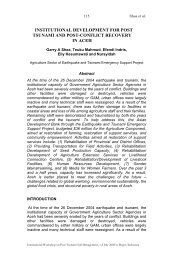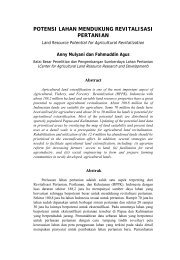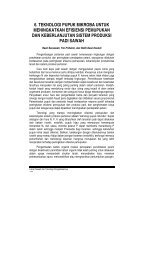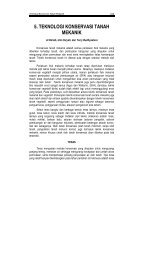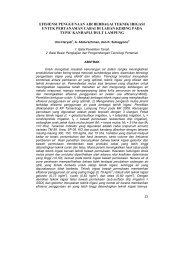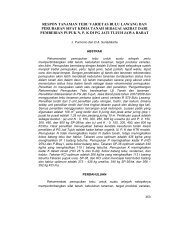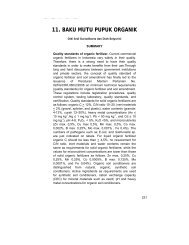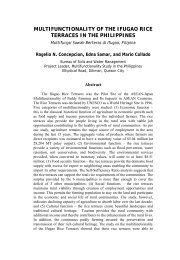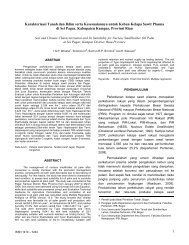Proceedings - Balai Penelitian Tanah
Proceedings - Balai Penelitian Tanah
Proceedings - Balai Penelitian Tanah
You also want an ePaper? Increase the reach of your titles
YUMPU automatically turns print PDFs into web optimized ePapers that Google loves.
Maldives<br />
24<br />
Niino Y<br />
Thirty-nine islands were damaged and nearly a third of the population,<br />
or 100 000 people, were affected. Fourteen islands were completely<br />
destroyed and had to be evacuated. Approximately 12,000 people<br />
were displaced from their islands, and another 8,500 temporarily<br />
relocated within their home island. It was estimated that the tsunami<br />
damaged field crops in 2,100 farms; destroyed home gardens and<br />
agricultural tools in 11,700 homesteads; and damaged more than<br />
700,000 fruit trees and 840,000 timber trees in inhabited islands. The<br />
damage to land and groundwater resources was severe in 35<br />
agricultural islands, and saline water intrusion affected 112 inhabited<br />
islands (FAO, 2006a).<br />
The geographical dispersion of the islands severely constrained the<br />
collection, collation and analysis of reliable data in a timely manner to<br />
inform the required immediate intervention responses of the<br />
Government and its supportive international development partners.<br />
The situation was further compounded by the lack of baseline data on<br />
the agricultural sector prior to the tsunami.<br />
In an effort to rehabilitate the agricultural sector, assistance focused<br />
on the replacement of basic production inputs to tsunami affected<br />
farmers and home gardeners; the strengthening of agricultural<br />
extension to facilitate the re-establishment of agriculture and<br />
horticulture; and the strengthening of agricultural institutional capacity.<br />
The main post-tsunami relief/recovery activities included the provision<br />
of a package of technical assistance through short-term<br />
consultants/experts, capacity building for farmers and MFAMR staff<br />
effected through training workshops and the distribution of<br />
replacement packages of agricultural assets (start-up agricultural kits<br />
comprising a range of selected inputs: seeds, seedlings, cuttings,<br />
fertilizer, compost and assorted implements).<br />
Myanmar<br />
The tsunami had a limited impact and was confined to areas of the<br />
Myanmar coastal zone. The Pyinsalu sub-township of Labutta<br />
Township was the worst affected area with 25 people losing their<br />
lives, more than 1,000 people left homeless and 289 houses totally<br />
destroyed. Four villages, namely Khar Pyat Thaung, Lay Yin Kwin,<br />
Kaingthaung and Aung Hlaing in the Pyinsalu sub-township were<br />
severely affected (FAO, 2005).<br />
The main goal of the assistance was to provide necessary assistance<br />
so as to resume the livelihoods of tsunami affected fishers and<br />
farmers with a focus on both the immediate and long-term. Farmers<br />
International Workshop on Post Tsunami Soil Management, 1-2 July 2008 in Bogor, Indonesia



